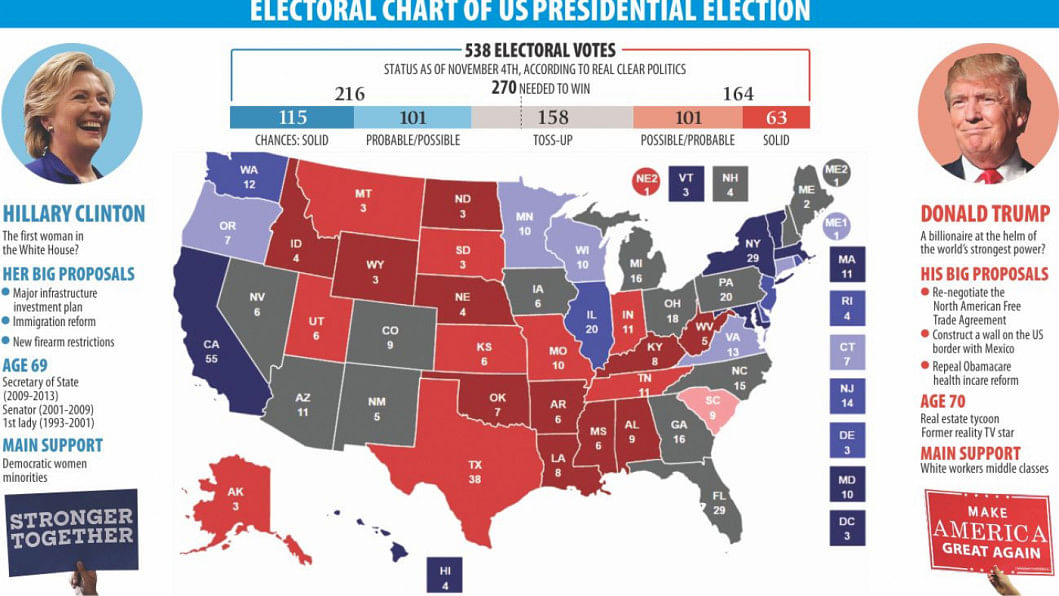How it all works

The assumption that you vote for a presidential candidate and the candidate with most votes wins does not necessarily work in the case of US presidential elections. Former vice-president Al Gore is a case in point.
Gore had beaten George W Bush by 5,43,895 votes in 2000 elections but he had lost Florida just by 537 votes, which was a tumultuous time in the US election history.
Bush winning Florida was all that mattered since the US president is elected by electoral votes of the 50 states and the District of Columbia, not by the popular vote.
Each of the 50 states has electoral votes equal to the number of representatives it has in the senate and congress, which depends on the population of a state and its areas. Big states have more representatives ie California has 55 electoral votes.
With the exception of Nebraska and Maine, if a candidate wins a state, he or she gets all the electoral votes the state has. This makes it imperative for a candidate to win states rather than getting the most number of votes.
With 538 electoral votes on offer, a candidate needs half of this plus one, 270, to start choosing the drapes for the White House.
Traditionally, democrats have an "easier" shot at getting to 270 since a number states with large number of electoral votes on offer usually stick to the blue team ie California, 55, and New York, 29.
Texas, 38, along with some smaller states like Oklahoma, 7, Alabama, 9, Kentucky, 8, usually go red.
What a candidate needs to do is sure up his or her base states and campaign in states that could go either way, usually called battleground states or swing states.
For example, Ohio, 18, went for the president every time since 1960. Florida, 29, too did the same but missed out on one occasion.
This election year the battleground states, according to realclearpolitics, are: Florida, 29, Ohio, 18, Michigan, 16, Pennsylvania, 20, New Hampshire, 4, Maine, 2, North Carolina, 15, Georgia, 16, Colorado, 9, Nevada, 6, Arizona, 11, New Mexico, 5, Iowa, 6, and Maine Congressional District-2, which carries one electoral vote.
Clinton/Kaine and Trump/Pence are very likely to get, if nothing catastrophic happens, 216 and 164 electoral votes respectively from states that are almost certain to go their way.
Clinton needs another 54 electoral votes and Trump a whopping 106 to get to the magical number 270. And all of them have to come from winning the battleground states which have 158 electoral votes.
The electoral college map puts Clinton in a slightly favourable position. If she wins Pennsylvania, Florida and North Carolina on November 8, Trump would be going to bed early while the Clinton camp would be partying all night.
All Clinton needs to do is hold on to the polls lead she has in Pennsylvania, 20, and North Carolina, 15, Virginia, 13, and make sure she doesn't lose any of the Great Lakes regions like Michigan, 16, Wisconsin, 10, Minnesota, 10, and she would be back to her former home.
If she wins Pennsylvania, 20, and Florida, 29, and North Carolina, it would be game over for Trump.
Trump on the other hand has an uphill task but he is riding on a momentum since late October when the FBI reopened Clinton's email controversy. Polls are moving in his favour gradually and promise a very tight race.
Trump has to make sure he wins every state Governor Mitt Romney won against Barack Obama in 2012. But Romney lost to the current US president so Trump needs to do even better and win most of the swing states and may be even steal a state or two from Clinton's purse.
It will be an uphill task but he has momentum, and US election history tells us momentum is key.
But Clinton has some heavy lifting surrogates campaigning for her. Her husband former president Bill Clinton, daughter Chelsea Clinton and President Barack Obama, First Lady Michelle Obama, who is actually more popular than her husband, and Clinton's former democratic rival Senator Bernie Sanders.
They have been campaigning for her for weeks and pushing her message to voters in key battleground states at the final stretch of the race. Clinton even got popular musicians Jay Z and Beyonce to perform in her rally in Ohio to drum up support for her.
It will certainly be an interesting and historic election in the USA on November 8, albeit for the right and wrong reasons.

 For all latest news, follow The Daily Star's Google News channel.
For all latest news, follow The Daily Star's Google News channel. 



Comments